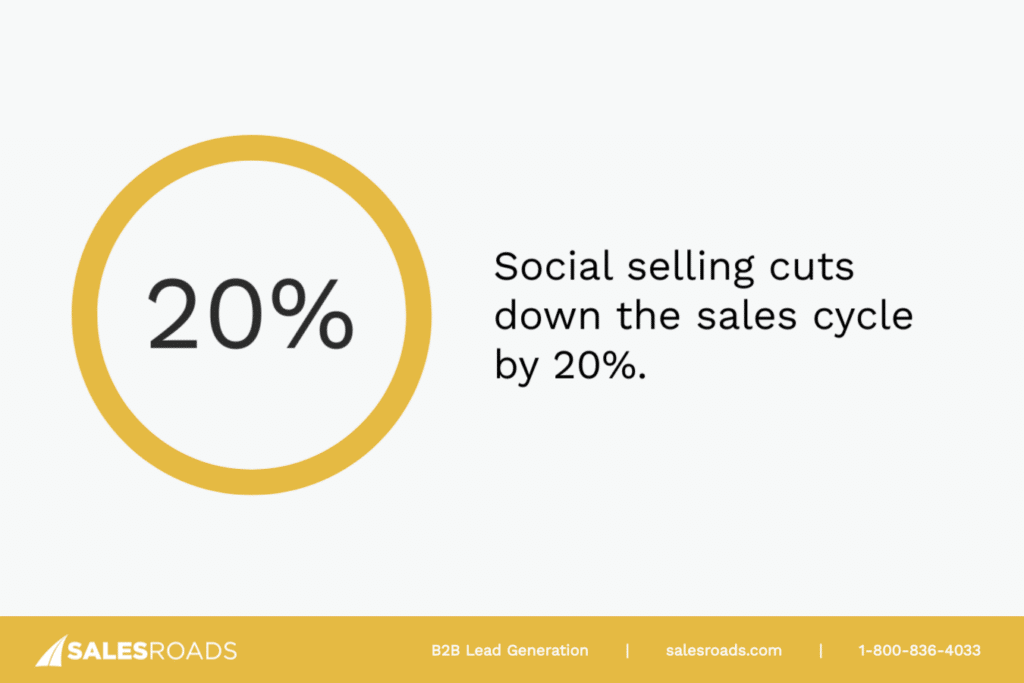In today’s rapidly evolving business landscape, sales strategies have undergone a profound transformation. While traditional selling remains an effective approach, it now enjoys the support of social selling and its dynamic capabilities.
As companies navigate this shift, it’s crucial that you figure out how to incorporate the new sales method into your existing strategy. In this article, we’ll explore the key differences and advantages between these two approaches to help you concoct a winning sales combination.
What Is Social Selling?
Social selling leverages social media and digital tools to connect with potential buyers, build relationships, and close deals. It focuses on researching, connecting, and interacting with prospects on channels like LinkedIn, Twitter, and Facebook.
Social selling relies on these platforms as potent tools for sales, as they permit sellers to engage with customers on the digital channels they frequent and trust.
This approach prompts businesses to align with the needs of modern consumers, who seek personalized, targeted interactions, not hard pitches or generic sales messages.
Sales coach Mohammed Nawaz emphasized the importance of genuineness on LinkedIn, stating, “I stand convinced that empathy is the vital factor in successful selling. Pushy and aggressive sales tactics are slowly phasing out, replaced by customers requiring a personalized and empathetic approach.”
The purpose of social selling is to learn the interests of your prospective buyers, uncover the challenges they face, and determine the ways your product or service can alleviate their problems.
With a strategic approach to social media, sales professionals can:
- Cultivate a personal brand
- Discover and connect with potential customers or referrals
- Generate and distribute valuable content to attract more leads
- Monitor online discussions for useful insights
- Engage in open dialogues, respond to queries, and offer help
The Benefits of Social Selling
Social selling brings multiple advantages that contribute to its growing popularity among sales professionals.
Build personal relationships
Cultivating meaningful relationships with buyers is a crucial aspect of social selling.
By understanding a prospect’s needs, interests, and challenges through their social media activity, sales professionals can tailor their approach, messages, and solutions to match those requirements. That, in turn, impacts buying decisions.

In fact, a HubSpot survey revealed that 69% of consumers state “the most influential factor in their purchasing decision is when salespeople listen to their needs and concerns.” Monitor social media channels to discover the problems potential customers face and respond to them directly (and promptly).
Social selling supports the creation of relationships that are personal and valuable for all parties involved.
Reaching out to a greater audience
Social media buzzes with activity round the clock, hosting billions of users worldwide. These platforms are a hotbed of potential customers.
A report from Statista elaborates on the sheer number of social media users, stating, “In 2022, over 4.59 billion people were using social media worldwide, a number projected to increase to almost six billion in 2027.” This statistic shows the vast potential of social selling for audience reach.
Social selling taps into the expansive connections of digital platforms to complement traditional sales methods and engage an even wider market segment.
As the Internet shrinks geographic distances, selling is becoming social, and audiences global.
Shortened sales cycle

Social selling holds a key advantage in its potential to reduce the length of the sales process — by as much as 20%, according to MarketSplash.
Information transparency and accessibility on social networks encourage swift decision-making, as potential buyers can educate themselves about products, services, and sellers ahead of time.
Cost-effectiveness
While traditional sales methods have their unique advantages and produce a tangible impact, social selling introduces an additional avenue for cost-effective engagement.
With just an Internet connection and a social media account, businesses can seamlessly interact with and nurture prospects.
Stay top of mind
Sharing valuable content and insights, commenting on posts, and answering questions on social channels help companies keep a high profile.
The marketing rule of 7 states that prospects should hear your message at least seven times before they take action to buy your product or service, and social selling allows you to create touch points multiple times, ensuring your company is top-of-mind when prospects need a solution.
What is Traditional Selling?
Traditional selling, often referred to as the outbound approach, revolves around initiating customer interactions through cold calling, direct mail, or face-to-face meetings.
The traditional method emphasizes ”physical” interactions to offer a personal and direct touch. The sales rep takes the lead, skillfully guiding the conversation to highlight the benefits of your product or service with the aim of converting.
The Benefits of Traditional Selling
Traditional selling brings advantages that hold value in the current marketplace thanks to the following factors:
Direct communication
One major appeal of traditional selling is its direct communication with consumers.
This sales approach enables immediate feedback through two-way conversation, which helps the seller clarify doubts, handle objections, and win the customer’s trust.
Highly focused sales efforts
The traditional approach grants businesses more control over the sales process. It facilitates immediate responses and guided conversations with tailored interactions based on consumer reactions.
It primarily concentrates on personalizing outreach efforts for each prospect, with salespeople tailoring their message to convince decision-makers. Sales reps, for instance, take notes during phone conversations with potential clients, utilizing this information to tailor their follow-up calls. This approach ensures their efforts are highly targeted and personalized, significantly enhancing the likelihood of successfully closing the deal.
Build long-term relationships
Traditional selling aids in building effective, lasting relationships with customers through direct conversations. These meetings develop a deeper understanding of client needs, in turn fostering long-term business relationships, loyalty, and referrals.
The personal nature of traditional sales leaves a lasting, positive impression of your brand in the customer’s mind.
How Social Selling and Traditional Selling Differ
Both traditional and social selling seek to achieve the same fundamental goal: to sell a product or service. However, they take different approaches to accomplish this.
Sales approach
Traditional selling typically starts with the seller reaching out to potential clients, often without any prior relationship established. This method is sometimes called “interruption-based.”
Social selling, on the other hand, usually begins when buyers express a need or interest.
For instance, a buyer comments on a LinkedIn post about a challenge they’re facing, and a social seller responds by providing a possible solution tied to their offering.
Relationship building
Traditional selling builds relationships through cold calling, cold emailing, one-on-one meetings, business lunches, or networking events, while social selling involves communicating through social media platforms and networking websites.
Through social selling, businesses can build connections on a broad scale. Sales professionals join groups, comment on posts, and share content to create and nurture relationships with potential buyers across the globe.
A shift from private modes of interaction to more public channels facilitates relationship-building with a larger group; however, direct interactions foster trust more effectively compared to cultivating relationships online.
List building
Traditional selling involves prospect lists built with internal and external resources throughout the years, while social sellers utilize the advanced search capabilities of social platforms to find interested prospects.
Both run the risk of targeting the wrong decision-makers. For instance, the Great Resignation has compromised the prospect lists of sales reps regardless of their strategy. It’s crucial for reps to regularly update their prospect lists.
Sales cycle
The sales cycle is often longer in traditional selling if the salesperson reaches out to prospects when they aren’t ready to make a buying decision. In that case, building relationships to convince the decision-maker takes more time.
However, sales reps can shorten the sales cycle by embodying social selling within their strategy. They can get in touch with prospects at the point of need, provide them with the right information, and swiftly nurture them so they move further down the sales funnel.
The Future: Balancing Both Concepts for Optimal Sales
Social selling is gaining traction in sales, but traditional methods haven’t lost their prominence. The future of sales is likely to manifest as a combination of these approaches, rather than one replacing the other.
Ray Makela, CEO of the sales training company Sales Readiness Group, supports this prediction, stating, “Using social selling techniques should be one of many different methods a sales professional uses to research, connect, and nurture their prospects and customers. It’s not social versus traditional sales methods, but rather social along with traditional methods that produce the best results.”
Consider a B2B software solutions company. Social selling enables the sales team to create awareness about the product, share relevant customer testimonials, and engage in industry discussions. Then, traditional selling methods like product demonstrations and outreach phone calls can provide the personalized touch needed to close the deal. This convergence of both methodologies embodies the ideal future of sales.
The Bottom Line
As the digital infrastructure continues to expand, the growing influence of social selling in sales is undeniable. It offers enticing advantages like a wider reach, immediacy, and large-scale engagement.
However, the traditional sales approach retains a powerful authority in the sales funnel. Its personal touch, direct interaction, and inherent trust-building potential can cement a brand’s place in the customer’s mind and foster lasting relationships.
The goal is to build authentic and meaningful relationships with customers to guide them toward conversion. An optimal strategy should then include a balanced combination of traditional and social selling techniques. By successfully uniting the two, you can establish a strong reputation for your brand both online and offline and expand your audience reach for increased sales.











